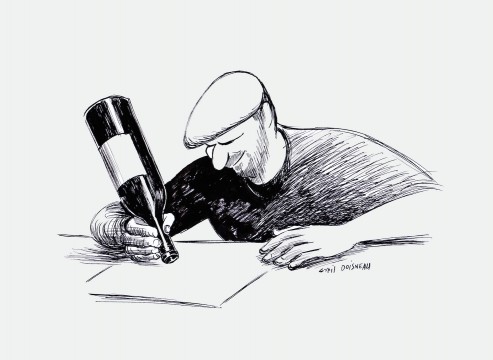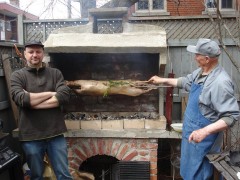
It’s the most wonderful time of year my friends. No, it’s obviously not Christmas. I’m referring to the OG of high holidays, Greek Orthodox Easter. This year it falls on April 8, one week after our dear friends the Catholics celebrate their version of Christ’s resurrection. And this is the time when the scent of roasting lamb fills the air everywhere a Hellene worthy of his name calls home. And while there is much religious ceremony surrounding Easter, every Greek will tell you the best part is when the coals are lit.
I grew up in a staunchly anti-religious home, very unusual for a Greek. My dad, being an old-school communist (even more unusual for a Greek) despised “organized religion” and never lost an opportunity to remind me “religion was the opiate of the masses”. But Easter was THE holiday in our home (we didn’t celebrate Christmas). My dad always respected and LOVED the cultural side of Easter. He always saw it as a great excuse for lots of food, wine, dancing, singing and the all-around good times when friends and family convened. And the main event was roasting a whole lamb. He hails from a small village on Mount Parnassos in Central Greece, very famous for its grilled and roasted meats. Their specialty is whole-roasted lamb on a spit as well as Kokoretsi, the pluck of the lamb skewered and wrapped in caul and small intestine and slowly roasted along side the lamb.
The importance of roasting lamb pre-dates Christianity. The Ancient Greeks would slaughter lamb every spring to honour the gods and celebrate the renewal of life in the world around them. It was, and still is, the most important celebration of the year, and Dionysius, God of Wine and Pleasure, oversaw the feast. The sacrificial lamb was the highest respect one could bestow upon the gods and made the festivity all the more significant.
In our home, there was a strict division of duty. My dad and I took care of the lamb, and my mom, everything else. That meant endless baking of savory pies like tyropita and spanakopita, and sweets like Koularakia and Tsoureki, as well as dyeing countless eggs that we would ceremoniously break as part of a “competition” to see who had the strongest egg in the pile.
The first step was choosing a lamb to roast. We would visit different butchers in town to assess the quality, size and price. The quality of the pluck was just as important for this would be made into the Kokoretsi. It had to be still attached to the animal, with the liver nice and shiny and the lungs a bright pink. We would also need plenty of intestines, and buying them was like buying heroin: very illegal and involving cash transactions behind the counter.
Once the lamb was purchased we would bring it home and season it simply with salt and pepper. We would truss it on the spit and let it rest overnight. We would then prep the Kokoretsi: the intestines would be soaked overnight in a salt and vinegar brine, and the pluck blanched and sliced in large chunks for the skewer. A portion of the pluck will be made into Mayeritsa, a soup that is eaten to break the fast and let the stomach know that an avalanche of meat awaits it. I still have memories of my dad slurping the soup first thing in the morning, its intense aromas wafting through the house.
Easter Sunday morning arrives and the coals are lit. I have to say that this is my favourite moment of the year. It signals, like in ancient times, the beginning of spring and a great feast to share with friends and family. The spit is placed above the coals with the Kokoretsi, and as the first drops of fat lick the coals and plumes of smoke rise, we give thanks for the good things in life: our health, our friends our family, and the tons of food and wine we are about to enjoy. We gather around with smiles and laughter and watch the beast spin in all its sacrificial glory to give us sustenance and pleasure.
How important is that?
Καλό Πάσχα!
